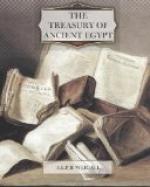But the curator generally has the insatiable appetite of the collector. The authorities of one museum bid vigorously against those of another at the auction which constantly goes on in the shops of the dealers in antiquities. They pay huge prices for original statues, vases, or sarcophagi: prices which would procure for them the finest series of casts or facsimiles, or would give them valuable additions to their legitimate collection of papyri. And what is it all for? It is not for the benefit of the general public, who could not tell the difference between a genuine antiquity and a forgery or reproduction, and who would be perfectly satisfied with the ordinary, miscellaneous collection of minor antiquities. It is not for that class of Egyptologist which endeavours to study Egyptian antiquities in Egypt. It is almost solely for the benefit of the student and scholar who cannot, or will not, go to Egypt. Soon it comes to be the curator’s pride to observe that savants are hastening to his museum to make their studies. His civic conceit is tickled by the spectacle of Egyptologists travelling long distances to take notes in his metropolitan museum. He delights to be able to say that the student can study Egyptology in his well-ordered galleries as easily as he can in Egypt itself.
All this is as wrong-headed as it can be. While he is filling his museum he does not seem to understand that he is denuding every necropolis in Egypt. I will give one or two instances of the destruction wrought by western museums. I them at random from my memory.
In the year 1900 the then Inspector-General of Antiquities in Upper Egypt discovered a tomb at Thebes in which there was a beautiful relief sculptured on one of the walls, representing Queen Tiy. This he photographed (Plate XXVI.), and the tomb was once more buried. In 1908 I chanced upon this monument, and proposed to open it up as a “show place” for visitors; but alas!—the relief of the queen had disappeared, and only a gaping hole in the wall remained. It appears that robbers had entered the tomb at about the time of the change of inspectors; and, realising that this relief would make a valuable exhibit for some western museum, they had cut out of the wall as much as they could conveniently carry away—namely, the head and upper part of the figure of Tiy. The hieroglyphic inscription which was sculptured near the head was carefully erased, in case it should contain some reference to the name of the tomb from which they were taking the fragment; and over the face some false inscriptions were scribbled in Greek characters, so as to give the stone an unrecognisable appearance. In this condition it was conveyed to a dealer’s shop, and it now forms one of the exhibits in the Royal Museum at Brussels. The photograph on Plate XXVII. shows the fragment as it appears after being cleaned.
[Illustration: PL. XXVII. A Relief
representing Queen Tiy, from the tomb
of
Userhat, Thebes.
—BRUSSELS
MUSEUM.
(See
PL. xxvi.)]




